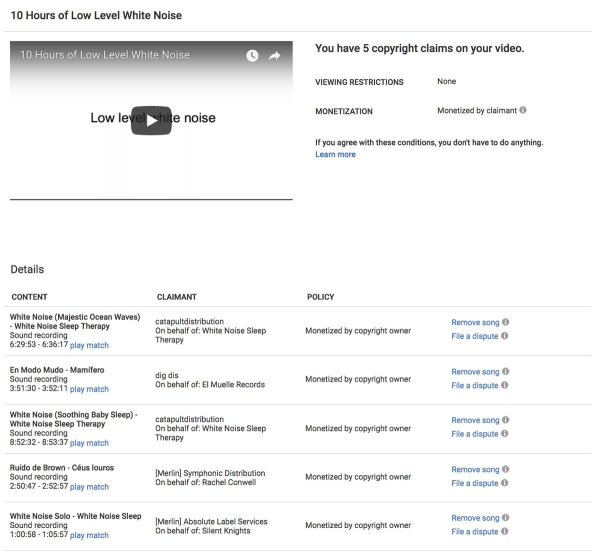Australian artist Sebastian Tomczak was confronted with  five different copyright claims after uploading a 10 hour YouTube noise recording - two of them from a "white noise"sleep therapy.
five different copyright claims after uploading a 10 hour YouTube noise recording - two of them from a "white noise"sleep therapy.
The guilt lies with YouTube or Google's  Content ID algorithm, which automatically detects sound passage from videos and compares it with a catalogue of sounds uploaded by copyright holders. In case of conformity, copyright claims will be filed in the name of the creator of the content. However, this new case once again shows that the system seems to have difficulties with the difference between music (to which copyright claims apply) and mere noises (such as white noise and - see below - birdsong).
Content ID algorithm, which automatically detects sound passage from videos and compares it with a catalogue of sounds uploaded by copyright holders. In case of conformity, copyright claims will be filed in the name of the creator of the content. However, this new case once again shows that the system seems to have difficulties with the difference between music (to which copyright claims apply) and mere noises (such as white noise and - see below - birdsong).

Noise - visual
Interestingly, the algorithm recognizes several claims to different places of 10 hours of white noise. The soundtrack of Tomczak's video is not to be removed, but monetized in favor of the copyright holders. Tomczak has challenged the copyright claims - it is not yet clear whether the copyright holders have maintained their claims.
A similar case occurred in 2012, when  YouTube saw a copyright infringement by bird singing in the audio background of a video injured. According to YouTube, the rate of invalid copyright claims is less than 1% - the only question is when and how YouTube recognizes that a claim is invalid and whether someone who files multiple invalid copyright claims or even insists on it will be punished.
YouTube saw a copyright infringement by bird singing in the audio background of a video injured. According to YouTube, the rate of invalid copyright claims is less than 1% - the only question is when and how YouTube recognizes that a claim is invalid and whether someone who files multiple invalid copyright claims or even insists on it will be punished.
How many copyright claims are there for "silence"?


